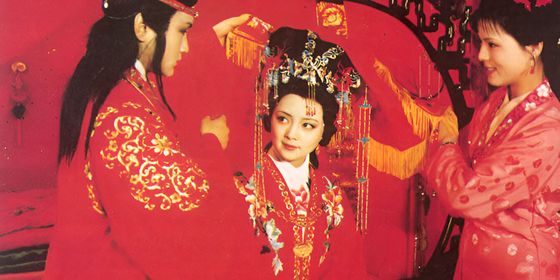Evolution of Chinese fox legends from religious icons to sexual warnings to modern epics
The year before the beats of the Chopsticks Brothers’ “Little Apple” began pulsating through every park and public square in China, middle-aged ladies across the nation were square-dancing to a lilting ballad of starcrossed love between a fox spirit and a human scholar. It’s a little difficult to imagine that “White Fox”— the theme song to a 2013 film critically panned for schmaltzy sexual content, referencing a mythical figure synonymous with “homewrecker” in modern Chinese language—could become a beloved vehicle of healthy exercise and folk dance. But then again, stories about the fox in China have always changed in the telling.
By the time of its release, “White Fox” was in good company concerning its reinterpretation of the fox. The version preferred by square dancers is actually a cover of the ending theme to a 2007 TV series, Liaozhai 2, which told tales of romance, revenge, and moral redemption in the interactions of mortals and spirits in the style of Pu Songling’s18th century anthology Liaozhai Zhiyi《聊斋志异》 (Strange Tales from a Chinese Studio). On the big screen, the two-part blockbuster Painted Skin franchise (with a third part due to be released this year) transformed Strange Tales’ famous horror story of the same name into a love triangle between a female fox spirit and a human couple, amply acted by dueling co-stars Vicky Zhao and Zhou Xun, ending with the fox redeemed (twice!) by compassion for a human but doomed as a result to disappearance or centuries of loneliness.
As expressed by the film review section of Sohu Entertainment, “the elements” of the first Painted Skin film—that is to say, the supernatural premise, period setting, and sexual tension between the male lead and both female co-stars—are the film’s marketing tools and “rather like a painted skin itself ”: the real “heart” of the film is about essential humanistic values, the necessary bridge between mere commercial cinema and modern classic in today’s media culture.
This wasn’t the first time that symbolism of the fox changed in the telling. Part of a millennia-old cult of worship in northern China, the early shamanistic traditions relating to the fox spirit (狐仙, húxiān) portray them as a neutral, powerful, and above all mystical manifestations of an essential force of nature. The fox could be an auspicious omen, such as the nine-tailed white fox seen by the legendary god-king, Yu the Great, that foretold the rise of his family and his momentous political achievements. In their interactions with humans, they have been shown to cure illness, save lives, share their centuries-old wisdom, and repay debts of kindness.
Foxes could also bewitch people, trick them, possess them, make them ill, seduce them, and steal their life force in their quest for immortality. Immortality, or becoming a “celestial fox”, is the ultimate goal that all fox spirits pursue through self-cultivation (or theft) over a period of 1,000 years. Like the association of foxes with the trickster archetype in Western mythology, fox spirits are neither good nor evil. Rather, as religious historian Xiaofei Kang detailed in her research on fox worship in Chinese history, fox magic is the ultimate representation of yin force in the universe; in the course of its cultivation, it is inexorably drawn to and seeks to unite with its opposite, the yang force, which it looks for among the society of humans.
Kang characterizes the fox as a figure that is “betwixt and between”. Not exactly deities to be worshipped, they were nonetheless treated with a properly fearful sense of awe. As beings on the peripheries of the mortal realm, taking on human characteristics yet transcending their mortality and morals, fox spirits also lent themselves to idealized representations of the boundaries of social behavior in any given era. Accomplished scholars and beautiful, refined women were two common forms taken by the fox in legends from the Tang Dynasty (618 – 907)—as were “foreigners” (胡, hú) from Central and Northeastern Asia who successfully made their home in Tang society, underlining their status as the simultaneously attractive and peripheral. The representations of the fox as alluring but dangerous sexual liaisons for humans, men especially, were likewise avenues by which societies sorted their feelings toward the illicit and unorthodox in human relations.
Stories of humans who had sexual relations with fox spirits were grounded in early shamanistic philosophies; according to these, the sexual union of yin and yang was considered to be the essential ingredient of the elixir of life. However, the rise of conservative doctrines, and especially neo-Confucianism since the 12th century, condemned these traditions as heterodox and malevolent attempts of the forces of yin (now considered to be indecent and inferior) to subjugate and corrupt the yang. The figure of the fox began to transform from a neutral, amoral representation of the duality of the natural order to an active threat to the Confucian moral order.
“Outfoxed” is a story from our newest issue, “Climate Change”. To read the whole piece, become a subscriber and receive the full magazine. Alternatively, you can purchase the digital version from the iTunes Store












